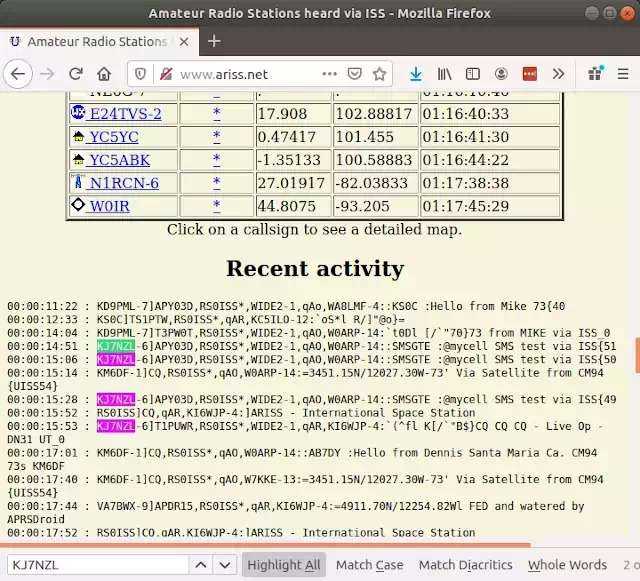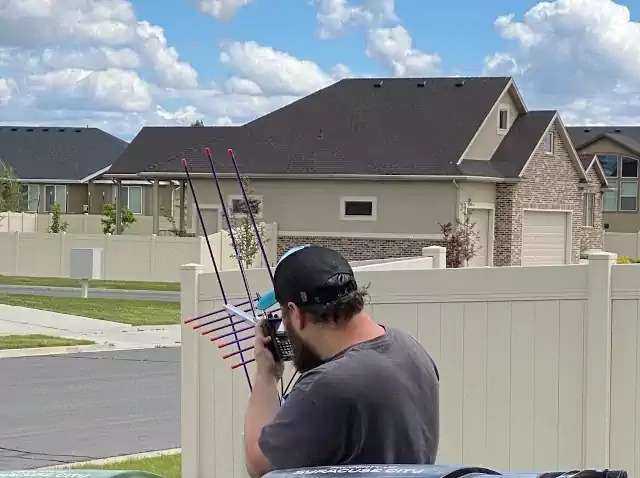Ham Radio, SMS, and the ISS
by Naught Robot
On Sunday July 12, 2020 at 06:00 UTC, I sent myself three SMS messages through the International Space Station's (ISS) Automatic Packet Reporting System (APRS) digipeater.
Here's how I did it and how you can too.
But first, let's discuss each component of this project for a bit.

A list of APRS messages retransmitted by the ISS.
The highlighted ones are sent by the author.
Ham Radio License
To legally transmit a radio single to the ISS, you'll need an amateur radio license issued by your country's government.
I know within the United States, Canada, and England there are multiple levels of license privileges. The basic license level for each country should grant you the permission to operate on the frequencies used by the ISS.
To be on the safe side, check with your local government to find out what requirements exist and the operating privileges provided with an amateur radio license. For the United States, a simple 35-question test is given and you need at least 74 percent to pass. The test question pool is openly available online so, with a little bit of preparation, it's simple to pass.
Ham Radio Aboard the ISS
The ISS has carried an amateur radio payload since its early beginnings.
Part of this payload includes a radio that serves as a digipeater for Automatic Packet Reporting System (APRS), which is an amateur radio-based system for instantaneous digital communications of information of immediate value in the local area.
Data can include object Global Positioning System (GPS) coordinates, weather station telemetry, text messages, announcements, queries, and other telemetry.
APRS data packets are typically transmitted on a single shared frequency (depending on country) to be repeated locally by area relay stations (digipeaters) for widespread local consumption. In addition, all such data are typically ingested into the APRS Internet System (APRS-IS) via an Internet-connected receiver (I-Gate) and distributed globally for ubiquitous and rapid access.
As the ISS orbits, hams within its footprint can send and receive data packets containing messages that can be used to make contact with each other. During any given pass, a number of various stations are transmitting. Some of these stations are just automatic beacons transmitting every few minutes and some are actually other hams trying to make contact with each other through the ISS's digipeater.
APRS SMS Gateway
The glue that holds this whole experiment together is APRS Satellite I-Gates and the SMSGTE APRS cellular gateway.
Without these two, an APRS packet could not be relayed by the ISS and sent to a cell phone.

The path an APRS packet travels to reach a user's cell phone.
APRS Satellite I-Gates listen on the 145.825 MHz frequency for APRS packets that are relayed by the ISS as it flies over. These packets are then routed through the APRS network to the SMSGTE gateway, onto an SMS cellular gateway, and finally through the cellular network to your phone.
To use the SMSGTE gateway, it's relatively straightforward.
All you need to do is transmit a message to SMSGTE in the following format: @[number] [message]
To: SMSGTE @1235551234 Hello from space! |
When the message is delivered, it will be displayed on the mobile phone like so:
@KJ7NZL-6 Hello from space! |
This is all you really need to do to start using the SMSGTE gateway, but if you want to mask a person's phone number within your APRS packets,you can achieve this by using an alias.
You can set these up by registering as a user on smsgte.org.
Sending an SMS Message Through the ISS
The key to sending an SMS message through the ISS is preparation.
For me, a typical ISS pass is about six minutes and thirty seconds long.
In that time I have to locate the ISS, queue up my message to the SMSGTE gateway, and transmit my message to the ISS.
I don't have a fancy setup with an azimuth and elevation rotor and circular polarized beam antennas; I'm merely working with my trusty Yaesu FT-3D radio and a handheld Yagi antenna. As a result, it takes a minute or two to find the ISS and you can easily lose track of it while navigating through the menus on the FT-3D with one hand.
To help shortcut some of the process, I actually construct the message on the FT-3D prior to the upcoming ISS pass and transmit on 145.825 MHz just before the ISS appears on the horizon. Since this message isn't received by anything, an acknowledgment isn't sent to the FT-3D.
This adds the message to a queue of unsent messages the FT-3D will try to resend after a minute or two. I'm able to manually try and resend these messages while they are in the queue. This allows me to focus on tracking the ISS while barely needing to check the radio's screen, only needing to for a few seconds at a time to make sure I click on the message transmit button.
Once the ISS receives my APRS message, a confirmation message from RS0ISS will display on my screen and I'll receive the SMS message on my phone a second or two later.
This sounds relatively straightforward, but in practice it took me a few weeks of trying to get the process down.
Interesting Facts About the ISS
- Traveling at 17,500 miles per hour (28,000 km/h), the ISS travels fast enough to orbit the Earth every 90 minutes at an approximate altitude of 250 miles (400 km).
- Although impossible to spot during daylight hours, the space station transforms into the third-brightest object against the blackness of the night sky.
- The ISS is officially the largest single structure humans have ever put into space.
